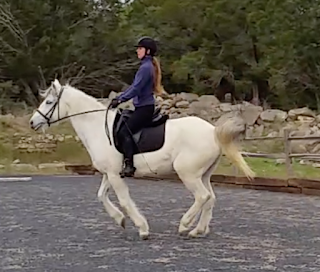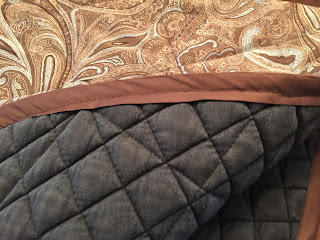I love saddle pads, but I rarely buy them. We have so many of them that, despite being 10 years old, are in pretty good shape. No tears, no holes, just some loose piping. However, they're sad and faded, and I'm more than a little bit tired of them. So I decided to pull some fabric out of my (terrifyingly large) collection and see what I could do about giving the pads a new look and some new life.
(If you're looking to make a saddle pad completely from scratch,
try this blog post for instructions. It also has slightly more detailed instructions on assembly than this post, so you might use it for reference.)
Sad, faded pad with loose piping, but otherwise sound and serviceable.
First, take a seam ripper and pull off all the piping and trim. If you've ever wondered what's in the middle of most saddle pads, it's a piece of 1/4 inch open cell foam (the yellowish stuff peeking out from the edge) - same stuff that's in your couch cushions. This is why most pads don't breathe very well.
Next, cut two pieces of fabric to roughly the right size. Be sure to leave about 2 extra inches on each piece over the spine area. Pin your cover fabric to the pad using LOTS of pins - the goal is to hold the fabric to the pad while we quilt it. Embiggen pic to see all the pins I used.
Use a straight edge and some chalk to mark the diagonal quilting lines going one way...
... then sew them down. Mark the lines going the other way, and sew those down too.
Once you've quilted the fabric on, run a line of stitches around the outside edge of the pad to make sure the fabric doesn't bubble or gap.
Snip away the excess fabric. It's starting to look like a saddle pad!
Next, we need to connect the two halves of our fabric over the horse's spine. Lay one side down flat (the one I'm holding on the left is the side I chose to lay flat - at the bottom of the pic, you can see how it's been tucked under the other piece of fabric)...
... then fold the other side over top to cover up the edge. You can see at the top of this pic, I've folded over the edge and pinned it, but I haven't done the part at the bottom yet.
Here's what it looks like all pinned in place. Use LOTS of pins!
This is Jen. Jen is an idiot and used a medium weight needle. Don't be like Jen. Use a heavyweight needle so it doesn't break when going through your saddle pad and heavy fabric.
You can run a second set of stitches down the spine if you want - I did it so it would look symmetrical, but it's not necessary. Here's what the spine of the pad looks like after everything has been stitched down.
Next up, the edging! I used double fold bias tape in a complimentary color. Bias tape is awesome because it's been cut on the diagonal (bias), which allows you to bend it neatly around curves.
Exhibit A: tidy curve with no wrinkles or folds. Once again, use lots of pins to make this work well. If it's wrinkling, use more pins. Seriously. And go slow when you're sewing it down.
Here's what the corner looked like after it had been stitched down and all the pins were removed.
Starting to look like a saddle pad!
You might be wondering what the back of it looks like - not so great. If you do much sewing you'll realize that I cheated when I sewed on the bias tape. I should have sewed it from the back side first, then stitched it down from the front. I did it all in one step because I'm lazy, but you can see that means the back doesn't turn out as nice. Whoops.
Check out this post for better instructions on how to sew on bias tape.
Next up, the piping! Use a seam ripper to make a very small hole in the stitching on your edging, then stuff the end of your piping in the hole. Tucking the end of your piping under your edging will prevent it from fraying.
Sew that sucker down, then use a big zig-zag stitch to go over your piping all the way around.
Here's what it should look like when you're done - you can just barely see the white thread I used to zig-zag over the piping to hold it down. You can also see the little lump in the edging that's the end of the piping.
Note that I chose not to put piping under where the girth goes. That's a high wear spot and I didn't want the piping to get rubbed.
Annnnd, the finished product!
I love the fabric I used for this and was pretty happy with how the whole thing turned out - as you can see, I pimped out a bonnet to match. One of the things I like the most is that this ensemble will go with a variety of outfits for the rider, if you're into that matchy-matchy thing. As part of our Spring 2016 collection, you should see Courage sporting this look on Aimee's blog... I wonder if she'll pair it with blue polos, or cream? ;)




















































